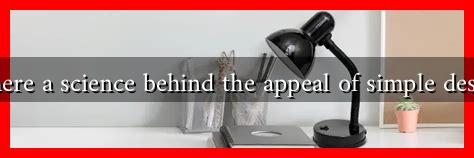-
Table of Contents
Is There a Science Behind the Appeal of Simple Designs?
In an age where technology and design are constantly evolving, the allure of simplicity remains a powerful force. From minimalist architecture to user-friendly interfaces, simple designs have captured the hearts and minds of consumers and creators alike. But what is it about simplicity that resonates so deeply? This article delves into the science behind the appeal of simple designs, exploring psychological, aesthetic, and functional aspects that contribute to their popularity.
The Psychology of Simplicity
At the core of the appeal of simple designs lies human psychology. Cognitive load theory suggests that our brains have a limited capacity for processing information. When faced with complex designs, our cognitive resources become overwhelmed, leading to frustration and disengagement. In contrast, simple designs reduce cognitive load, making it easier for users to understand and interact with products.
- Familiarity: Simple designs often draw on familiar shapes, colors, and patterns, which can evoke a sense of comfort and ease.
- Clarity: A straightforward design communicates its purpose effectively, allowing users to navigate and utilize it without confusion.
- Emotional Response: Research indicates that simplicity can elicit positive emotional responses, enhancing user satisfaction and loyalty.
Aesthetic Appeal: The Beauty of Minimalism
Minimalism, a design philosophy that emphasizes simplicity and functionality, has gained significant traction in various fields, including graphic design, architecture, and product design. The aesthetic appeal of minimalism can be attributed to several factors:
- Visual Harmony: Simple designs often feature clean lines and balanced compositions, creating a sense of visual harmony that is pleasing to the eye.
- Focus on Essentials: By stripping away unnecessary elements, minimalism allows the core message or function of a design to shine through.
- Timelessness: Simple designs tend to age better than complex ones, as they are less likely to be tied to specific trends or fads.
For example, the iconic Apple logo is a prime illustration of minimalist design. Its simplicity has made it instantly recognizable and timeless, contributing to Apple’s brand identity and success.
Functionality: The Practical Benefits of Simple Designs
Beyond aesthetics and psychology, simple designs often offer practical advantages that enhance user experience. Here are some key functional benefits:
- Ease of Use: Simple designs are typically more intuitive, allowing users to accomplish tasks with minimal effort.
- Faster Learning Curve: Users can quickly learn how to interact with simple designs, reducing the time and resources needed for training.
- Accessibility: Simple designs can be more inclusive, catering to a wider range of users, including those with disabilities.
Consider the success of Google’s homepage, which features a simple search bar against a white background. This design prioritizes functionality, allowing users to focus on their search without distractions.
Case Studies: Brands That Embrace Simplicity
Several brands have successfully leveraged the power of simple design to enhance their market presence:
- Airbnb: The platform’s clean interface and straightforward navigation have made it easy for users to find and book accommodations.
- Dropbox: With its minimalist design, Dropbox emphasizes functionality, making file sharing and storage intuitive for users.
- IKEA: The furniture giant’s simple product designs and assembly instructions have revolutionized the way consumers approach home furnishing.
Conclusion: The Enduring Appeal of Simplicity
The science behind the appeal of simple designs is multifaceted, encompassing psychological, aesthetic, and functional dimensions. As our world becomes increasingly complex, the desire for simplicity will likely continue to grow. Brands that embrace simple design principles not only enhance user experience but also foster emotional connections with their audience. In a landscape filled with distractions, simplicity stands out as a beacon of clarity and effectiveness.
In summary, the allure of simple designs is rooted in our cognitive preferences, aesthetic sensibilities, and practical needs. As we move forward, understanding and applying these principles will be crucial for designers and brands aiming to create meaningful and impactful experiences.
For further reading on the psychology of design, consider exploring resources from the Nielsen Norman Group.

